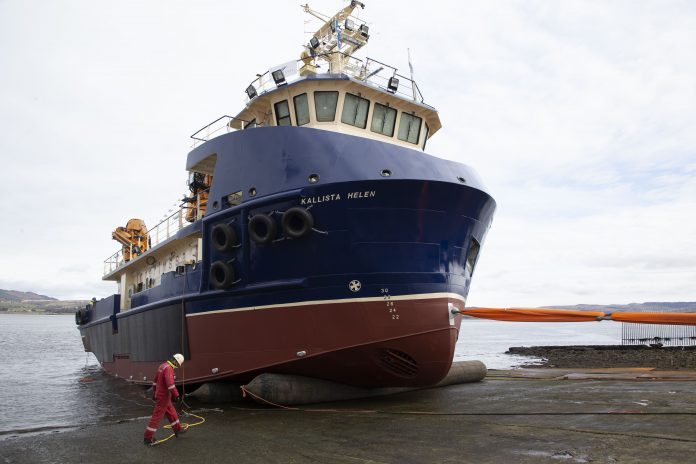“Kallista Helen” on long-term lease. It is the first vessel of its type to be designed and built-in Scotland around a thermolicer system.
In a press release, Scottish Sea Farms (SSF) writes that the multi-purpose service vessel “Kallista Helen” was launched by Ferguson Marine (Port Glasgow) on a long-term lease from Mull-based Inverlussa Marine Services.
ScaleAQ
The GBP 6 million vessel will be fitted with a GBP 2.5 million next-generation Thermolicer, designed and engineered by ScaleAQ in Norway, in partnership with ScaleAQ UK.
“Designed by Macduff Ship Design in partnership with Inverlussa and Scottish Sea Farms, the new vessel will enable the salmon producer to intervene earlier with regards to sea lice control, helping safeguard farmed fish health,” wrote SSF.
Commenting on the collaboration between Scottish marine businesses, Rural Economy Secretary Fergus Ewing said: ‘I welcome this partnership which is using innovative technology to address key challenges faced by the sector. Aquaculture is a vital sector for Scotland’s economy, creating many highly paid, highly skilled jobs across the country, many of which are in rural and remote communities. The Scottish Government is committed to supporting the sustainable growth of Scottish aquaculture and its wider supply chain.”

Fish health and welfare
Inverlussa managing director Ben Wilson said the “Kallista Helen”, named after his niece, was built with fish health and welfare front of mind.
“From the outset, Scottish Sea Farms was looking to minimise fish handling and maximise fish welfare, designing the boat around those. The result is so much better when you start with the fish then consider the boat, rather than the other way round,” he said.
The first of its kind to be constructed in Scotland, the system includes:
- A simpler, straighter pipe layout creating a gentler experience for the fish.
- A wider than standard pipe of 600mm diameter to ensure a smoother journey through the system.
- Increased capacity of up to 120 tonnes per hour.
- 150-micron filtration to separate and collect the dislodged sea lice for removal from the marine environment.
“In another first, the service vessel has been custom-built to house this delousing technology internally within a dedicated sheltered deck to protect it from the elements; the advantages being better operational efficiency, improved seaworthiness and safer working conditions for the crew,” wrote SSF.
This also frees up more space on the vessel’s top deck for equipment, including three cranes which means the vessel will be less dependent on other workboats during treatments.
Meanwhile, down in the engine room, there is a heat recovery system to draw heat from the engines and transfer it to the delousing system, saving on both fuel usage and carbon emissions.
“Kallista Helen”
SSF Managing Director Jim Gallagher said: ‘Not only is the “Kallista Helen” another important step forward in our drive to ensure the best growing conditions for our fish, it’s also a great example of Scottish business supporting Scottish business from drawing board through to final deployment.
‘Events outside everyone’s control have caused delays but we’ve stuck together throughout, stayed focused on the end goal and now we’re back on course,” said Gallagher.
The “Kallista Helen” is expected to arrive in Shetland in early May where it will be fitted out by Scale AQ’s Scottish team and Ocean Kinetics of Lerwick.
Once works are complete, the vessel will operate with two five-strong crews – one from SSF, the other from Inverlussa, each working three week on/off shift patterns.

